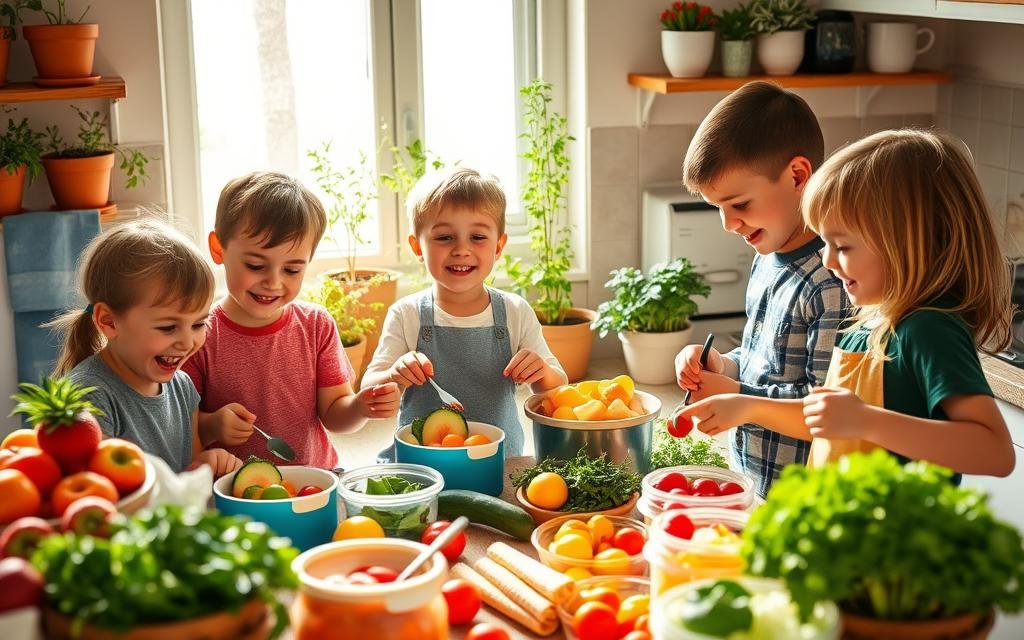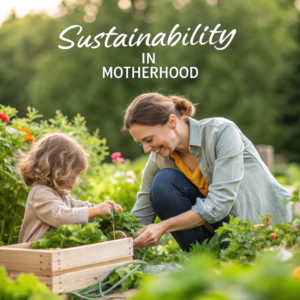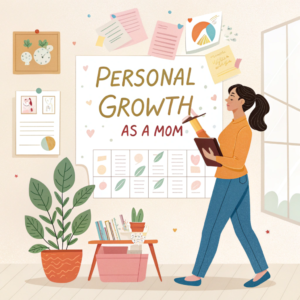Key Takeaways
- Encourage your kids to eat a variety of fruits and vegetables to promote healthy eating habits1.
- Involve your kids in the cooking process to help them develop positive eating habits and try new foods1.
- Choose eco-friendly kids meals and sustainable food options to reduce the environmental impact of food choices2.
- Provide your kids with hands-on food education and involve them in meal planning and grocery shopping2.
- Support organizations that promote nutrition education and provide resources for sustainable eating3.
Understanding Sustainable Eating for Kids: A Parent's Guide
As a parent, you are key in teaching your child about food and the environment. By using nutritious and sustainable kids recipes, you help them eat well and learn about nature. The Kid’s Healthy Eating Plate is a tool from Harvard T.H. Chan School of Public Health. It helps kids see the importance of eating right and staying active4.
Here are some kid-friendly sustainable eating tips to start with:
By following these tips, you can help your kids develop good eating habits. This also helps them understand the environment better. Together, we can make a more sustainable future5.
Starting Your Family's Sustainable Food Journey
Starting to make your kids’ diets more sustainable is a big step. It’s important to get everyone in your family involved. Serving a variety of healthy foods and snacks helps kids learn good eating habits7.
Having regular family meals is also key. It lets kids try new foods and feel good about eating7.

Here are some tips to start your family’s sustainable food journey:* Get kids involved in cooking and planning meals* Pick foods that are in season and from local farms* Reduce waste by composting and eating mindfully* Encourage kids to try new foods and enjoy eating7
Kid-Friendly Plant-Based Meal Ideas
Choosing eco-friendly food for kids is key. Start with plant-based meals that taste great and are good for the planet. For breakfast, try pancakes with special flours, oatmeal, or scrambled eggs10. These foods are good for toddlers and don’t waste much.
For lunch, pack a mix of fruits, veggies, and grains. Add nuts, seeds, or dried fruits for snacks. Vegan burritos, burgers, and tacos are tasty and waste-free11. They’re also good for your child’s health.
For dinner, pick meals rich in protein and fiber. Vegan soups, stews, or curries are tasty and green11. They’re better for the planet than meat.
Here are some healthy snack ideas for kids:
- Fresh fruits like mango, strawberries, and blueberries
- Vegetables like jicama, carrots, and celery
- Nuts and seeds like almonds and sunflower seeds
- Whole grain crackers with hummus or avocado spread
| Meal Idea | Ingredients | Eco-Friendly Benefits |
|---|---|---|
| Vegan Burrito | Whole grain tortilla, beans, vegetables, guacamole | Reduced food waste, sustainable ingredients |
| Vegan Sweet Potato Soup | Sweet potatoes, vegetables, lentils, whole grain bread | Locally sourced ingredients, minimal packaging |
Shopping Smart: Sustainable Food Choices at the Grocery Store
Shopping smart is key for sustainable eating for kids. Choose whole grains, lean meats, and lots of fruits and veggies. Try to avoid sugary drinks and unhealthy snacks12. This helps kids eat healthy and supports the planet.
Make a shopping list with your kids. Pick their favorite healthy food choices for children and plan meals together12. Teach them about budgeting and comparing prices. This way, you teach them important life skills while promoting sustainable eating for kids.
Here are some more tips for smart shopping:
- Plan your shopping route to save time and avoid impulse buys12
- Bring healthy snacks to stop buying too much
- Involve your kids in shopping to teach them about healthy food choices for children and sustainable eating

By using these tips, you can help kids eat better and be kinder to the planet13.
| Food Group | Recommended Daily Intake |
|---|---|
| Fruits | 2-3 servings |
| Vegetables | 3-5 servings |
| Whole Grains | 3-5 servings |
Growing Your Own Food with Kids
Growing food with kids has many benefits. They eat more fruits and veggies. They also spend more time together and learn about where food comes from15. Start with fast-growing plants like green beans and grape tomatoes. They grow quickly and keep kids excited about gardening14. Indoor gardens with grow lights let kids garden all year round14.
Here are some tips to get started:
- Start a kitchen garden with easy-to-grow plants like herbs and leafy greens
- Involve kids in every garden activity, from planting to harvesting
- Use indoor grow lights to facilitate year-round gardening
- Make it fun by planting colorful flowers and vegetables

Making Sustainable Food Fun and Engaging
When it comes to sustainable eating for kids, making mealtime fun is key. Kids should help plan and prepare eco-friendly kids meals. This helps them learn to eat healthy16.
Studies show that “Farm to Table” programs can make kids eat more veggies by 50%17.
To make sustainable food fun for kids, try these tips:
- Involve them in meal planning and grocery shopping
- Teach them about different types of sustainable food, such as locally sourced produce and organic meats
- Encourage them to try new fruits and vegetables
By making food fun, kids are more likely to eat healthy for life18. As a parent, you can help shape your child’s eating habits. This can help them love sustainable food.

Together, we can make food better for the future. Start small in your kitchen, like reducing waste and using reusable bags18. Every little bit helps, and we can all make a difference.
| Benefits of Sustainable Eating | Impact on Kids |
|---|---|
| Reduces carbon footprint | Teaches kids about environmental responsibility |
| Promotes healthy eating habits | Helps kids develop a love for nutritious food |
| Supports local farmers | Encourages kids to try new, locally sourced foods |
Reducing Food Waste in Your Home
Here are some tips to reduce food waste:
- Plan meals and make a shopping list to avoid buying too much
- Use leftovers in new ways, like turning last night’s dinner into tomorrow’s lunch
- Compost food waste to send less to landfills
These steps can make a big difference in reducing waste and being more sustainable at home. Every little bit helps, and together, we can make a big change20.

By cutting down on food waste, you help the planet and teach your kids about sustainability. This teaches them to care for the environment and develop good eating habits for life19.
Teaching Kids About Food Sources and Seasons
Teaching kids about food sustainability can be fun. You can make it exciting by using kid-friendly tips. This helps them understand where food comes from and why eating seasonally is good. Studies show kids who learn this make better food choices later21.
Teach kids about food labels by reading them together. Explain what each term means. You can also visit a local farm to learn about food production and the benefits of local ingredients22. Planning meals with fresh ingredients from each season is another way to engage kids in seasonal eating.
Teaching kids about food sources and seasons has many benefits. They learn where food comes from and the value of eating seasonally. This encourages them to make healthier food choices and eat a balanced diet23.
- Developing a deeper understanding of where their food comes from
- Learning about the importance of seasonal eating and locally sourced ingredients
- Encouraging healthier food choices and a balanced diet
By using these tips, you can help your kids appreciate sustainable eating. They will have a healthier relationship with food for life23.

Teaching kids about food sustainability is a long-term effort. It needs patience, creativity, and consistency. Make it fun and engaging to help them develop healthy habits for life21.
| Season | Fresh Ingredients | Meal Ideas |
|---|---|---|
| Spring | Strawberries, spinach, asparagus | Salads, smoothies, grilled vegetables |
| Summer | Tomatoes, corn, bell peppers | Grilled vegetables, salads, fresh fruit salads |
| Autumn | Pumpkins, apples, sweet potatoes | Soups, stews, roasted vegetables |
| Winter | Citrus fruits, kale, carrots | Soups, stews, roasted vegetables |
Sustainable Eating Beyond the Home
Here are ways to eat sustainably outside the home:
- Choose restaurants with sustainable food options for children
- Go for plant-based or locally sourced meals
- Stay away from foods with lots of packaging waste

These small changes help our food system and kids’ health. Every step we take matters. Promoting sustainability through kids’ diets makes a big difference25.
Conclusion: Nurturing a Sustainable Future Through Children's Food Choices
FAQ
What is sustainable eating for kids?
Sustainable eating for kids means choosing food that’s good for them and the planet. It’s about more than just what they eat. It’s also about how that food affects the Earth.
Why is sustainable eating important for kids?
It’s key for kids because it helps them eat well and care for the planet. It teaches them to make choices that are good for the Earth from a young age.
How can I teach my kids about food sustainability?
Involve your kids in planning, preparing, and growing food. Talk about how food choices affect the environment. Make mealtime fun and educational.
What are some kid-friendly plant-based meal ideas?
For kids, try healthy breakfasts, lunches, dinners, and snacks. Use fruits, veggies, whole grains, and plant-based proteins. They’ll love it!
How can I reduce food waste in my home?
Use leftovers in creative ways, store food right, and compost with your kids. These steps teach them to waste less and care for the Earth.
What are the benefits of seasonal eating for kids?
Seasonal eating connects kids to food, the environment, and the seasons. It introduces them to more fruits and veggies. It’s good for their health and the planet.
How can I make sustainable eating fun and engaging for my kids?
Involve your kids in meal planning and prep. Let them try new recipes. Make mealtime a positive, bonding experience. Add fun educational activities.















